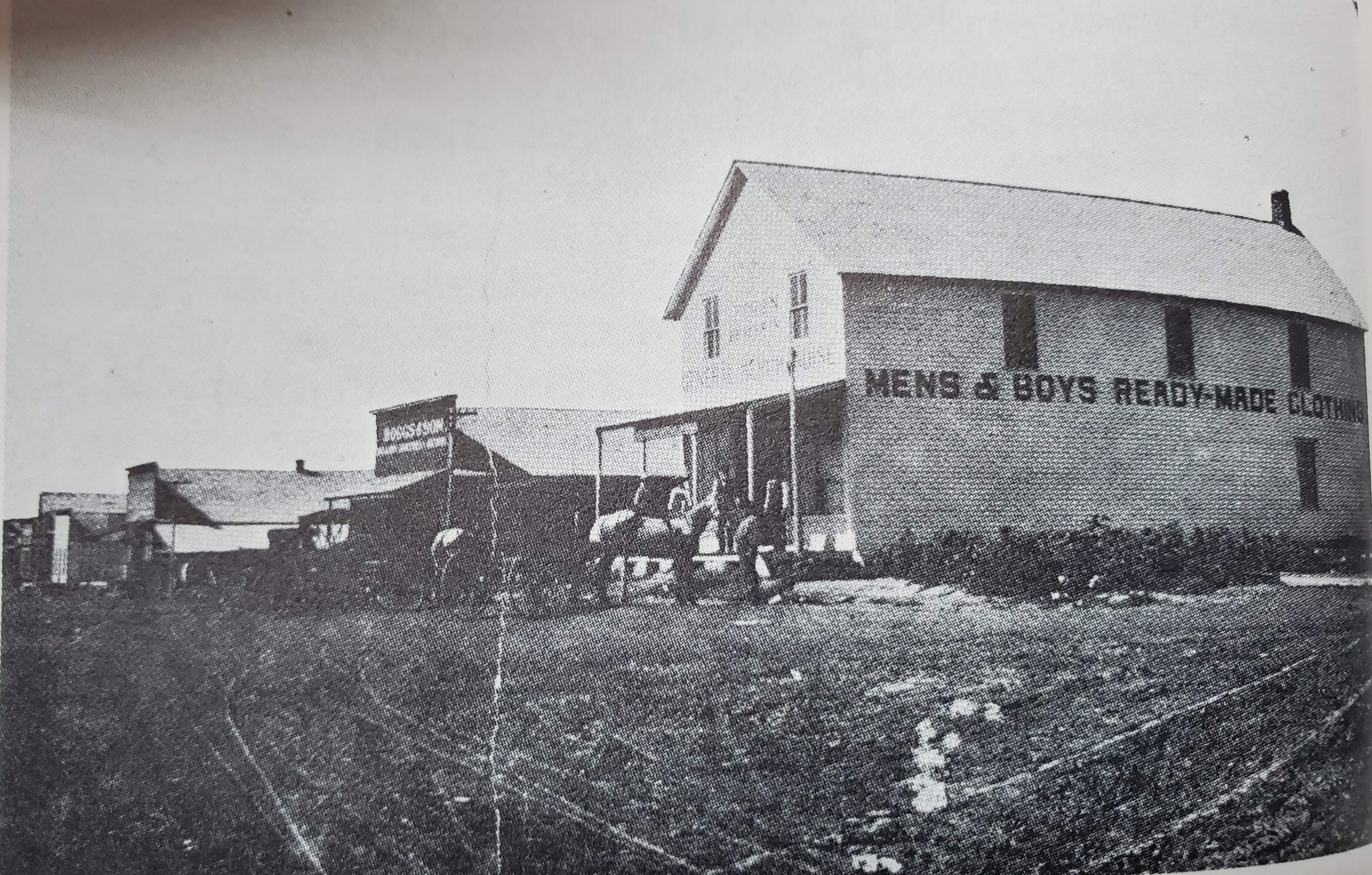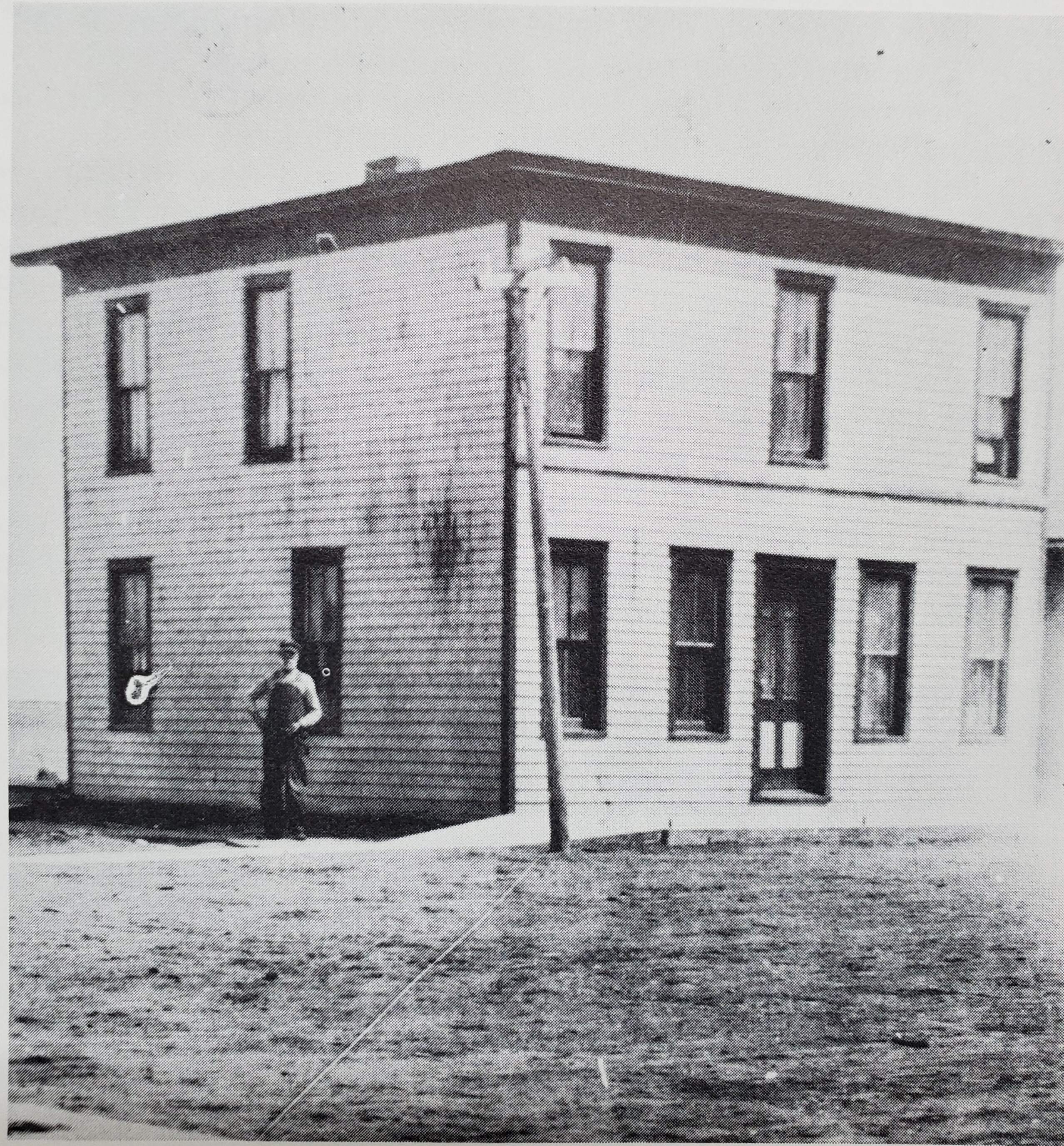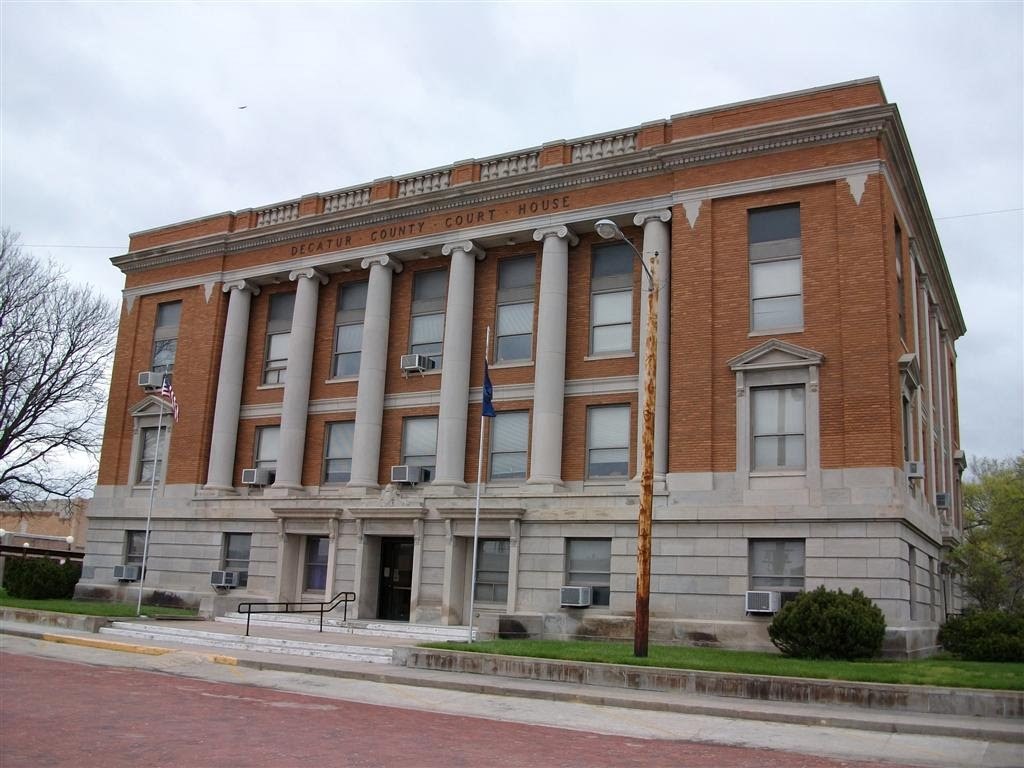-

Early Main Street Kanona -

Fawcett Hotel Kanona
Kanona
The Kanona school playground is silent and the little old white church is empty. Most of the streets have disappeared and the sidewalks are crumbling. Amid weeds and underbrush are structures in various stages of deterioration. Only the Kanona grain elevator has survived the onslaught of changing times. It stands like a sentinel in the night, guarding all that remains of this once thriving little village.
Kanona, which is located in Altory township, can trace its beginning to the coming of the Burlington and Southwestern Railroad. The town site was platted on 26 June 1885 by Anselmo B. Smith or the Lincoln Land Company of Lincoln, Nebraska.
It is not known when the first building was constructed in Kanona but on 5 November 1885, Levi Kindig has an advertisement in the Oberlin Herald announcing NEW TOWN, NEW STORE, KENONA (spelled with an “e”). Soon Dopps and Bradley and Charles Yarker also had General Stores. The Chicago Coal and Lumber Company, of Polk County, Iowa built a lumberyard. Matt Kaspar owned property where there was a blacksmith shop. Mark Simpson put in a livery barn and Keiser and Williams were in the flour and feed business. Charles N. Page ran a Land and Loan Office and John Himmelberger erected the Kanona House with a restaurant and rooms for sleeping.
On the Southside of the railroad tracks was the Kanona depot. It was a two-story frame building with living quarters upstairs for the station agent and the telegraph, ticket, and freight office below. The depot was destroyed by fire in March 1935.
Through the years the Kanona community saw many business establishments come and go. During the depression of the 1890′s many families left the area. The Chicago Coal and Lumber Company closed and John Caldwell bought the office building and sheds and moved them to his farm.
In 1893 Levi Kindig sold his general store for $395 to Charles Orbin, who was to become a legend in the history of Kanona. Other grocery and dry goods merchants known to have shops in Kanona were: William McCalla; A.A. Engstrom; Addleman and Campbell; Boggs & Son; Campbell, Dean, and Wilbur; Lanning; Adolph Johnson; George and Ottie Jorn; George Fiala; and Gilbert Brown. The last grocery store in Kanona was owned by Gilbert Brown and was ran by Ethel and Warren Vernon.
Proprietors of livery barns included: Mark Simpson; Keiser and Williams; J.A. Stinson; Sherman Bailey; Willie Bissell; and L.W. “Pete” Gill. With the coming of automobiles, the livery barn was converted into a garage. Among Kanona mechanics were: Hugo Von Schuetz; W.R. Stramp: Ben Harman; l.A “Abe” Worley; G.A. White; Harry Fortner; Art Peareau; F.A. Mead; Joe Fiala; and Gilbert Brown. Ray and George Vernon not only had a garage but were also the agency for Nash cars.
Gilbert Brown and the Kanona Equity Exchange Elevator had pumps to supply gas for the horseless carriages. Tank wagon service was provided to the rural area by Elmer Rushton, along with others.
J.D. Harris started a branch hardware store in Kanona in June 1887. William Landau was agent for Perkins windmills and in 1893 he added a line of farm implements and hardware. Other Kanona hardware dealers were Porter Stephenson, John Frickey, L.A. Whittier, O.K. and H.K. Sanford, Jim Stinson, J.E. Fields and Hiram Gilbert. In 1911 W.C. “Sham” Hoppas bought out Gilbert. He became a representative for International Harvestor. George Heller also handled implements and hardware.
By December 1901, Kanona was booming again and the Woods Brothers, Tim and Bill, put in a large stock of lumber and hard- ware. B.N. Mason owned the yard for a short time but in 1907, Tim Woods was back in his old business and the lumberyard went by the name of Yates Lumber Company. After Woods retired, the yard was managed by Charles Gloss, F.R. Richards, a man named Capron, and George Fiala. In 1917 the business changed hands and became known as the W.P. Seawell Lumber Company. Frank Shurtliff and then G.W. Case managed the yard. In 1947, Seawell Lumber Company sold the buildings to Bert “Babe”Miller and they were used for storage. The office building was used as a residence for a number of years.
In the early days, all small communities needed a blacksmith. Matt Kaspar, P.B. Hughes, S.B. Shortridge, John Sears, Alanson Bacon, Rollie Haskett, and Wash Hatch all served as village blacksmith in Kanona.
A charter for the Kanona State Bank was filed 2 August 1915 by a group of Norcatur men. Capital stock was $10,000 with ten thousand one dollar shares. A frame building was erected on lot two, block six. The bank opened for business on 5 March 1917. Directors were H.A. Hanson, Dick Nelson, A.P. Laughlin, and J.A. Stinson. In September 1919 construction began on a new red brick building which still stands forlornly in the rubble of the once busy little town. For a time the bank prospered, providing funds for the farmers between harvests, then things started going bad. On 7 August 1926, the board of directors held a special meeting in the banking room with the following present: lim Woods, F.J. Ruzicka, John Lacy, C.F. Orbin, and Frank Chapman. It was decided to close the bank and Dale R. Ainsworth was instructed to take charge. In later years, the bank building was used for a grocery store.
Butcher shops in Kanona were ran by Nicholas Gill, Carl McMullin, Guy Whitney, and Albert Janousek.
Among the barbers in Kanona were Joe Gregory, Mr. Guinn, John B. Garrison, Joe McCormick, and C.E. “Butch” Hall. In later years, L.E. “Tobe” Griffin cut hair in his home.
Farmers organized the Kanona Creamery and Shipping Association in August 1902 and a creamery was built on the Jim Stinson property north of the railroad tracks. Hitchcock, H.E. Gilbert, George Heller, Verna and Bessie Soderlund, Mrs. Z.A. Worley, Velma Berg, Mary Guinn, and Mrs. J.E. Fawcett bought and sold eggs, cream, and butter in cream stations in Kanona. Mackey brothers put in a pool hall in the old bank building in 1921, much to the disapproval of the mothers as well as many of the fathers in the community. The pool hall was in business only a short time when it was destroyed by fire. There were a number of eating establishments in Kanona. Food was served at the Kanona House. Meals and lodging were available at J.B. Mitchells; and Addleman and Campbell ran a grocery store and restaurant. Joe Gregory had a restaurant in connection with his barbershop. Other cafe operators included Effie Lee, Sanfords, L.W. Gill, Homer Easley, Sam Morton, Abe Worley, Glenn White, A.T. McCrary, Lyle Guinn, Mary Skeels, A.A. Spicer, George Heller, and Mike Stockberger.
One of the first telephone lines in the county was put in between Kanona and Jennings in 1904. Patrons included the Johnsons, Browns, Hegrees, Krizeks, Cileks, and Steffins. Switchboards, called “central offices” were located at Jennings and Kanona.
The central office was located in the home of the telephone operator until 1919 when the association built a small two-roomed office on the west side of Sheridan Avenue. When Rural Telephone Service Company, Inc. bought up the lines, the Kanona switchboard was abandoned to make way for progress. The first post office in the area was called “Altory” and was located in the Lewis Johnson home, two miles east of the Kanona townsite. When Levi Kindig became postmaster on 8 March 1886, the office was moved to his general store in Kanona but due to political red tape the name was not officially changed to Kanona until 4 April 1887. The post office was moved from place to place in Kanona, depending on who was the current postmaster or postmistress. The following people were in charge of the post office: Levi Kindig, Charles N. Page, Everette S. Sutton, William Landau, Charles Orbin, John B. Garrison, Earl M. Zimmerman, George J. Heller, Bessie Case Soderlund, Lizzie M. Case, Mamie Hale, Ottie Jorn, George A. Fiala, Mryna Mackey, Ethellva Vernon, and George Warren Vernon. The post office was discontinued 31 March 1955.
Early church records for Kanona are sketchy. Sunday Schools were organized and revivals and protracted meetings were held. In 1891 Rev. J.A. Hoff was assigned to the Kanona Circuit. On 19 November 1900, articles were signed authorizing a board of trustees to transact business for the Kanona Methodist Episcopal Church. A charter was granted 6 March 1902 with G.E. Cody, G. Brown, J.E. Fawcett, and C.W. Orr as directors. In 1906 a white frame church was constructed and Sunday school and church services were held here until 31 May 1958 when it was declared abandoned and sold.
There was also a Church of Christ in Kanona. They met in the old one room schoolhouse. On 25 May 1907 this group purchased property in Kanona, probably with the intention of building a church. The lots were sold to Nicholas Gill, 16 June 1921 with F .U. Harmon, Eva H. Woods, H.E. Brown and Fred Landau signing the deed. The Kanona School district 68 was formed 1 March 1886, and perfected 26 March 1886. In the fall a white frame one-room schoolhouse was built in the southeast part of town in block ten. This schoolhouse was to serve the community until 1920 when a square, red brick, story and a half edifice was erected. The worst tragedy to ever befall Kanona occurred 9 October 1949 when a tornado destroyed the brick schoolhouse as well as much of the remaining town.
Not to be discouraged by disaster, the teachers held classes in the church parsonage until another school building was purchased and moved to the site. In March 1950, the patron of the district voted to build a new building and school was held there until unification forced closing in 1966. Today, the schoolhouse is used as a community center and voting place. Kanona was a shipping and grain center. Stock pens were built on the north side of the railroad tracks and here livestock was loaded and shipped to distant markets.
At one time Kanona boasted having three grain elevators, the first being built by Harris, Woodman and Company. Central Granaries Company built corn cribs in Kanona in 1893 and in 1907 they built an elevator. H.Q. Banta and Jim Stinson put up elevators.
The Kanona Cooperative Mercantile Equity Exchange Was organized in 1916. They rented the Banta elevator for a time and then constructed a. White Star elevator just east of Stinson’s. Glen Wookey was the first manager. The Banta elevator closed during the twenties. Jim Stinson continued in the grain business until his death in July 1941. The Kanona Coop prospered and a. warehouse was added. During the years of bumper crops additional storage was built Wayne Landau managed the business for a number of years. In June 1970, the Equity Exchange found itself in serious financial difficulty and was taken over by the Decatur County Co-op Association. In 1982, this is the only business still in operation in Kanona.
Gilbert Brown made a valiant struggle to keep Kanona alive: He started purchasing lots and soon had title to almost all of the property in town. Unfortunately Gilbert failed to induce merchants to return to Kanona. After his death, Wayne Lohoefner purchased the town site with its ram shackled buildings. Although the town is all but gone, it will live on in the memories of those who once called Kanona home.
Decatur County Kansas history booksAvailable for purchase in the County Clerk's Office.
$30.00 each, payable by check or cash
Decatur County Kansas history books
$30.00 each, payable by check or cash


